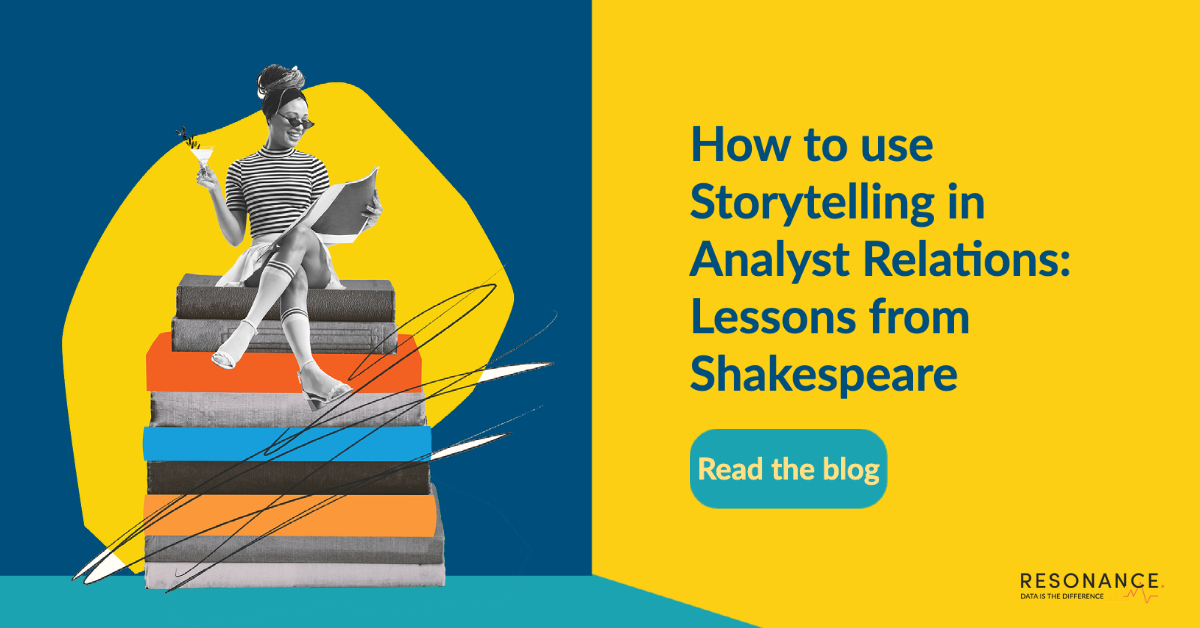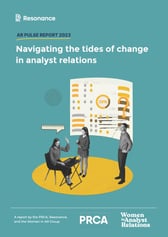3 min read
How to use Storytelling in Analyst Relations | Lessons from Shakespeare
Claire Williamson : Apr 3, 2023 3:30:38 PM

As an analyst relations professional, you are constantly trying to communicate complex information in a way that is compelling and easy to understand. One way to do this is through storytelling.
Storytelling is the art of using a narrative to convey information or make a point. It can be a powerful tool for communicating with analysts, who are often looking for clear and concise explanations of complex topics.
In this blog post, we'll explore the art of storytelling for analyst relations, including the key elements of a good story.
Prologue: Setting the Stage
Every good story starts with a prologue, which sets the stage for the story to come. In the case of analyst relations, the prologue might include some background information about your company or the industry you operate in. This can help provide context for the story you are about to tell, and help analysts understand why the information you are sharing is important.
Characters: Who's Who in the Story
The next key element of a good story is the characters. In the case of analyst relations, these characters might include your company, your competitors, your customers, or even the analysts themselves. It's important to clearly define these characters and their roles in the story, so that analysts can follow along and understand the implications of the information you are sharing.
Scene: The Setting and Environment
The scene is another important element of storytelling. This refers to the setting and environment in which the story takes place. In the case of analyst relations, the scene might include the market landscape, the competitive landscape, or the regulatory environment. It's important to clearly define the scene, so that analysts can understand the context in which the story is taking place.
Conflict: The Problem to Solve
Every good story needs a conflict to drive the narrative forward. In the case of analyst relations, the conflict might be a problem that your company is trying to solve, or a challenge that the industry as a whole is facing. It's important to clearly define the conflict, so that analysts can understand the stakes and the potential impact of the information you are sharing.
Plot: The Sequence of Events
The plot is the sequence of events that make up the story. In the case of analyst relations, the plot might include the steps your company is taking to solve the problem, or the trends that are shaping the industry. It's important to clearly define the plot, so that analysts can follow along and understand the implications of the information you are sharing.
Resolution: The Solution
Every good story needs a resolution, where the conflict is resolved and the story comes to a satisfying conclusion. In the case of analyst relations, the resolution might be the solution that your company has developed to solve the problem, or the implications of the trends you have identified. It's important to clearly define the resolution, so that analysts can understand the impact of the information you are sharing.
Conclusion: What We Learned
Finally, every good story needs a conclusion, where you sum up the key takeaways and lessons learned. In the case of analyst relations, the conclusion might include recommendations for how analysts should think about your company or the industry going forward. It's important to clearly define the conclusion, so that analysts can understand the implications of the information you have shared.
Storytelling is a powerful tool for communicating complex information in a compelling and easy-to-understand way. By using the key elements of storytelling - prologue, characters, scene, conflict, plot, resolution, and conclusion - you can craft a narrative that resonates with analysts and helps them understand the key takeaways and lessons learned. So the next time you are trying to communicate with analysts, consider using the art of storytelling to help get your message across.
Lessons from Shakespeare
While Shakespeare may seem like an unlikely source of inspiration for technology vendors, there is actually a lot that can be learned from his approach to storytelling.
- Understand your audience: Shakespeare was a master of writing for his audience, and he understood what would capture their attention and keep them engaged. Technology vendors should also understand their audience - who they are, what they care about, and what challenges they are facing. By tailoring your message to your audience, you can increase the likelihood of making a connection and ultimately making a sale.
- Tell a compelling story: Shakespeare's plays are known for their compelling stories, and the same is true for successful analyst briefings. Instead of simply presenting a list of features and benefits, technology vendors should aim to tell a story that demonstrates how their product can solve a specific problem or meet a particular need.
- Use vivid language: Shakespeare's use of language is legendary, and technology vendors can take a page from his book by using vivid and descriptive language to paint a picture of the problem they are solving and the benefits of their solution. This can help to make your message more memorable and engaging.
- Create a sense of urgency: Shakespeare knew how to create dramatic tension and a sense of urgency in his plays, and technology vendors can do the same by highlighting the consequences of not addressing the problem their solution solves. By creating a sense of urgency, you can help engage the analysts
- Offer social proof: Shakespeare's plays were often performed in front of live audiences, and the same is true for successful analyst relations briefings. By offering social proof in the form of testimonials or case studies, technology vendors can demonstrate that their solution has worked for others and is worth considering.
While the world of analyst relations may seem far removed from the works of Shakespeare, there is actually a lot that can be learned from his approach to storytelling. By understanding your audience, telling a compelling story, using vivid language, creating a sense of urgency, and offering social proof, technology vendors can improve their chances of making a successful sale.



 "The intricacies of the data-driven landscape is written into the DNA of Resonance. We are built for the data economy."
"The intricacies of the data-driven landscape is written into the DNA of Resonance. We are built for the data economy.".jpeg?width=250&height=181&name=AdobeStock_565367297%20(1).jpeg)
 "In Tech PR we have a front row seat to the changing technology landscape. From Generative AI to Quantum, it's our job to insert our clients' voices into the narrative"
"In Tech PR we have a front row seat to the changing technology landscape. From Generative AI to Quantum, it's our job to insert our clients' voices into the narrative"



 "In a world where the only constant is change, how do tech brands stay one step ahead of the market? That's where Resonance comes in"
"In a world where the only constant is change, how do tech brands stay one step ahead of the market? That's where Resonance comes in".png?width=219&height=219&name=Seb%20Moss%20wavelength%20thumbnail%20(1).png)

 "Resonance is a group of technology, business and communications experts"
"Resonance is a group of technology, business and communications experts"

